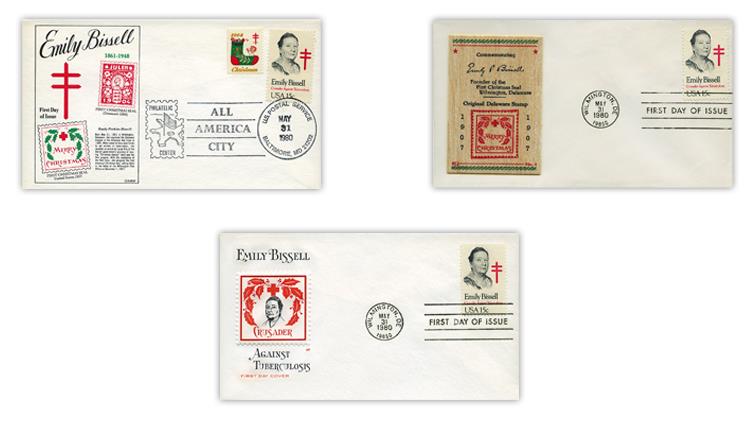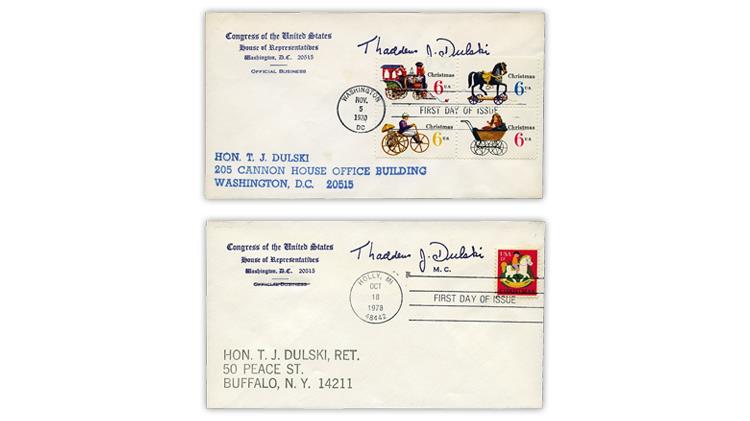US Stamps
Collecting FDCs for the 1980 15¢ Emily Bissell stamp
U.S. Stamp Notes by John M. Hotchner
Collectors of first-day covers who get seriously bitten by the bug are never satisfied having just one cover for each stamp.
The left side of the FDC has long served as a palette for artists who use it to expand upon the information conveyed by the stamp or to picture associated elements that relate to the stamp’s design. This artwork is called a cachet.
I have delved into the FDC field for certain stamps I find significant. One of these is the 1980 15¢ commemorative honoring Emily Bissell (Scott 1823). A social worker and activist, Bissell lived from 1861 to 1948.
Not a household name? She deserves to be as she is as responsible for the conquering of tuberculosis as anyone else.
How? She invented the United States Christmas seal in 1907, used ever since to generate hundreds of millions of dollars for TB research and research on other lung ailments.
Bissell borrowed the idea from Denmark, which pioneered the concept, and became a one-woman force to make it happen in the United States.
She designed the first U.S. Christmas seal and also had them printed; raised seed money from friends; convinced the Wilmington, Del., post office to allow her to sell the seals (at 1¢ per seal) in its lobby; and persuaded the editor of a Philadelphia newspaper to publicize the availability of the seals.
With a goal of $300, she raised $3,000 that first year. With the assistance of the American Red Cross, the idea went national in 1908, raising an astounding $135,000, equivalent to nearly $3 million in today’s dollars.
There are likely hundreds of different Bissell FDC cachets. My collection has only 25. Three of my three favorites are shown in Figure 1.
For those interested in FDC collecting, a wonderful resource is the American First Day Cover Society. For information, visit the AFDCS website or write to AFDCS, Box 246, Colonial Beach, VA 22443-0246.
Dulski first-day covers
Congressional franked envelopes were valid as postage only for official business. However, the envelopes could be used for personal purposes as long as the user put the proper postage on them.
Some congressmen and senators who were stamp collectors used their envelopes to make FDCs. One such legislator was Rep. Thaddeus J. Dulski (1915-1988), a Democrat from New York who served in the House of Representatives from 1959 to 1974.
From 1967 to the end of his congressional career, Dulski served as chairman of the House Post Office and Civil Service Committee, where he helped shape the legislation that created today’s U.S. Postal Service.
I was able to acquire a run of FDCs that he made, including for Christmas stamps issued from 1962 through 1978. Two examples are shown in Figure 2. One is for the 1970 block of four 6¢ contemporary Christmas stamps featuring classic toys (Scott 1415-1418), and the other is for the 1978 15¢ stamp showing a child on a hobby horse (1769).
My guess is that multiple FDCs were created for each stamp issue and distributed to friends, influential constituents and donors known to be stamp collectors. I don’t have letters that prove this, but I’ve seen similar letters from other congressmen and senators who used FDCs as a means of wooing voters.
Why he continued to make the covers after his retirement I don’t know, but he continued to use his congressional stationery. Waste not, want not, I suppose.
Connect with Linn’s Stamp News:
Sign up for our newsletter
Like us on Facebook
Follow us on Twitter
MORE RELATED ARTICLES
Headlines
-
World Stamps
Oct 8, 2024, 3 PMRoyal Mail’s Oct. 1 definitive meets new international standard rate
-
World Stamps
Oct 8, 2024, 12 PMPostcrossing meetup Oct. 9 at U.N. headquarters
-
Postal Updates
Oct 7, 2024, 5 PMUSPS plans to raise postal rates five times in next three years
-
US Stamps
Oct 7, 2024, 3 PMMcMurtrie dismissed as APS education director following Sept. 21 arrest










